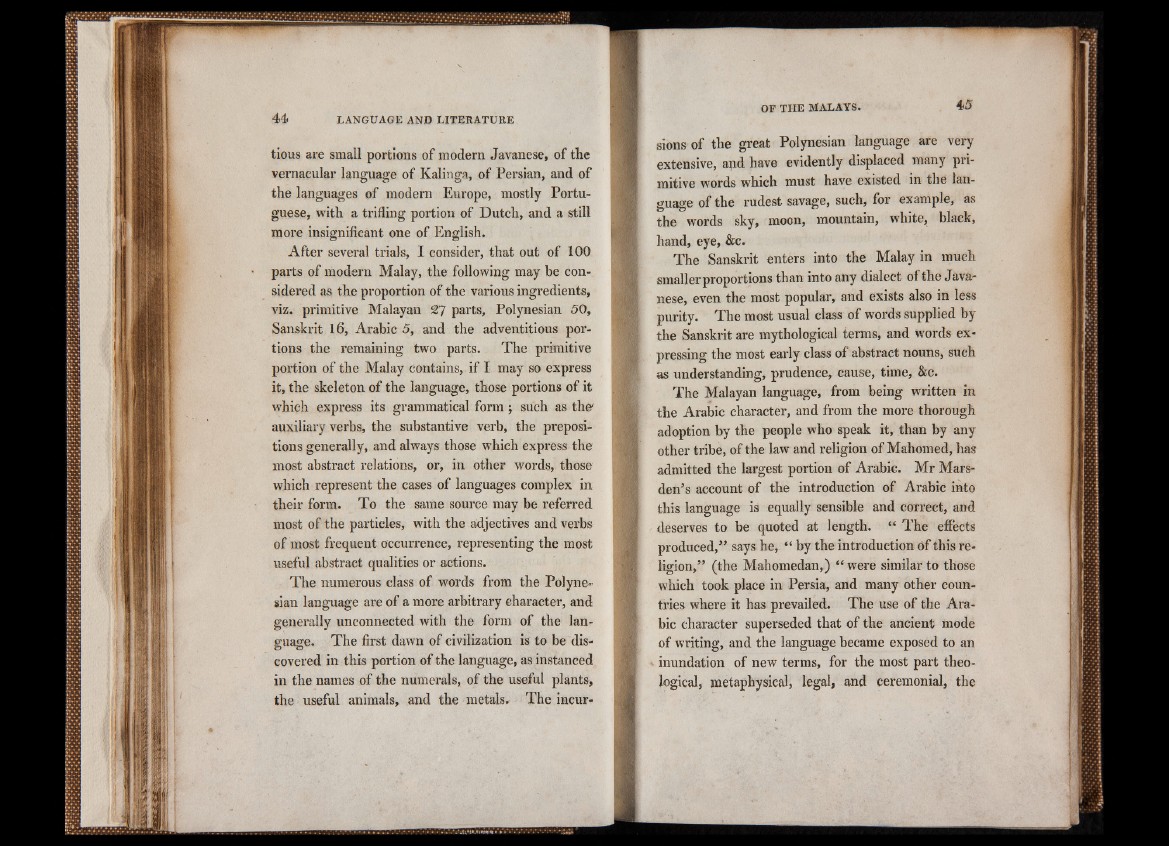
tious are small portions of modern Javanese, of the
vernacular language of Kalinga, of Persian, and of
the languages of modern Europe, mostly Portuguese,
with a trifling portion of Dutch, and a still
more insignificant one of English.
After several trials, I consider, that out of 100
parts of modern Malay, the following may be considered
as the proportion of the various ingredients,
viz. primitive Malayan %T/ parts, Polynesian 50,
Sanskrit 16, Arabic 5, and the adventitious portions
the remaining two parts. The primitive
portion of the Malay contains, if I may so express
it, the skeleton of the language, those portions of it
which express its grammatical form; such as the7
auxiliary verbs, the substantive verb, the prepositions
generally, and always those which express the
most abstract relations, or, in other words, those
which represent the cases of languages complex in
their form. To the same source may be referred
most of the particles, with the adjectives and verbs
of most frequent occurrence, representing the most
useful abstract qualities or actions.
The numerous class of words from the Polynesian
language are of a more arbitrary character, and
generally unconnected with the form of the language.
The first dawn © © of civilization is to be dis- covered in this portion of the language, as instanced
in the names of the numerals, of the useful plants,
the useful animals, and the metals. The incursions
of the great Polynesian language are very
extensive, and have evidently displaced many primitive
words which must have existed in the language
of the rudest savage, such, for example, as
the words sky, moon, mountain, white, black,
hand, eye, &c.
The Sanskrit enters into the Malay in much
smaller proportions than into any dialect of the Javanese,
even the most popular, and exists also in less
purity. The most usual class of words supplied by
the Sanskrit are mythological terms, and words expressing
the most early class of abstract nouns, such
as understanding, prudence, cause, time, &c.
The Malayan language, from being written in
the Arabic character, and from the more thorough
adoption by the people who speak it, than by any
other tribe, of the law and religion of Mahomed, has
admitted the largest portion of Arabic. Mr Mars-
den’s account of the introduction of Arabic into
this language is equally sensible and correct, and
deserves to be quoted at length. “ The effects
produced,” says he, “ by the introduction of this religion,”
(the Mahomedan,) “ were similar to those
which took place in Persia, and many other countries
where it has prevailed. The use of the Arabic
character superseded that of the ancient mode
of writing, and the language became exposed to an
<. inundation of new terms, for the most part theological,
metaphysical, legal, and ceremonial, the